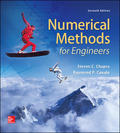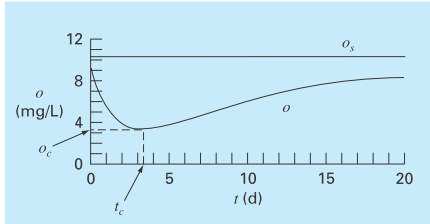
Concept explainers
TheStreeter-Phelps model can be used to compute the dissolved oxygen concentration in a river below a point discharge of sewage (Fig. P16.17),
where
As indicated in Fig. P16.17, Eq. (P16.17) produces an oxygen “sag” that reaches a critical minimum level

FIGURE P16.17
A dissolved oxygen “sag” below a point discharge of sewageinto a river.
below the point discharge. This point is called “critical” because it represents the locationwhere biota that depend on oxygen (like fish) would be the most stressed. Determine the critical travel time and concentration, given the following values:
Want to see the full answer?
Check out a sample textbook solution
Chapter 16 Solutions
EBK NUMERICAL METHODS FOR ENGINEERS
- 2. Consider the ODE u' = ƒ (u) = u² + r where r is a parameter that can take the values r = −1, −0.5, -0.1, 0.1. For each value of r: (a) Sketch ƒ(u) = u² + r and determine the equilibrium points. (b) Draw the phase line. (d) Determine the stability of the equilibrium points. (d) Plot the direction field and some sample solutions,i.e., u(t) (e) Describe how location of the equilibrium points and their stability change as you increase the parameter r. (f) Using the matlab program phaseline.m generate a solution for each value of r and the initial condition u(0) = 0.9. Print and turn in your result for r = −1. Do not forget to add a figure caption. (g) In the matlab program phaseline.m set the initial condition to u(0) = 1.1 and simulate the ode over the time interval t = [0, 10] for different values of r. What happens? Why? You do not need to turn in a plot for (g), just describe what happens.arrow_forwardTrue or False and whyarrow_forward10 5 Obtain by multiplying matrices the composite coordinate transformation of two transformations, first x' = (x + y√√2+2)/2 y' = z' (x√√2-2√2)/2 z = (-x+y√√2-2)/2 followed by x" = (x'√√2+z'√√2)/2 y" = (-x'y'√√2+2')/2 z" = (x'y'√√2-2')/2.arrow_forward
- Not use ai pleasearrow_forward4 The plane 2x+3y+ 6z = 6 intersects the coordinate axes at P, Q, and R, forming a triangle. Draw a figure and identify the three points on it. Also find vectors PQ and PR. Write a vector formula for the area of the triangle PQR and find its value.arrow_forwardAND B A Ꭰarrow_forward
- Algebra & Trigonometry with Analytic GeometryAlgebraISBN:9781133382119Author:SwokowskiPublisher:Cengage
 Linear Algebra: A Modern IntroductionAlgebraISBN:9781285463247Author:David PoolePublisher:Cengage Learning
Linear Algebra: A Modern IntroductionAlgebraISBN:9781285463247Author:David PoolePublisher:Cengage Learning


